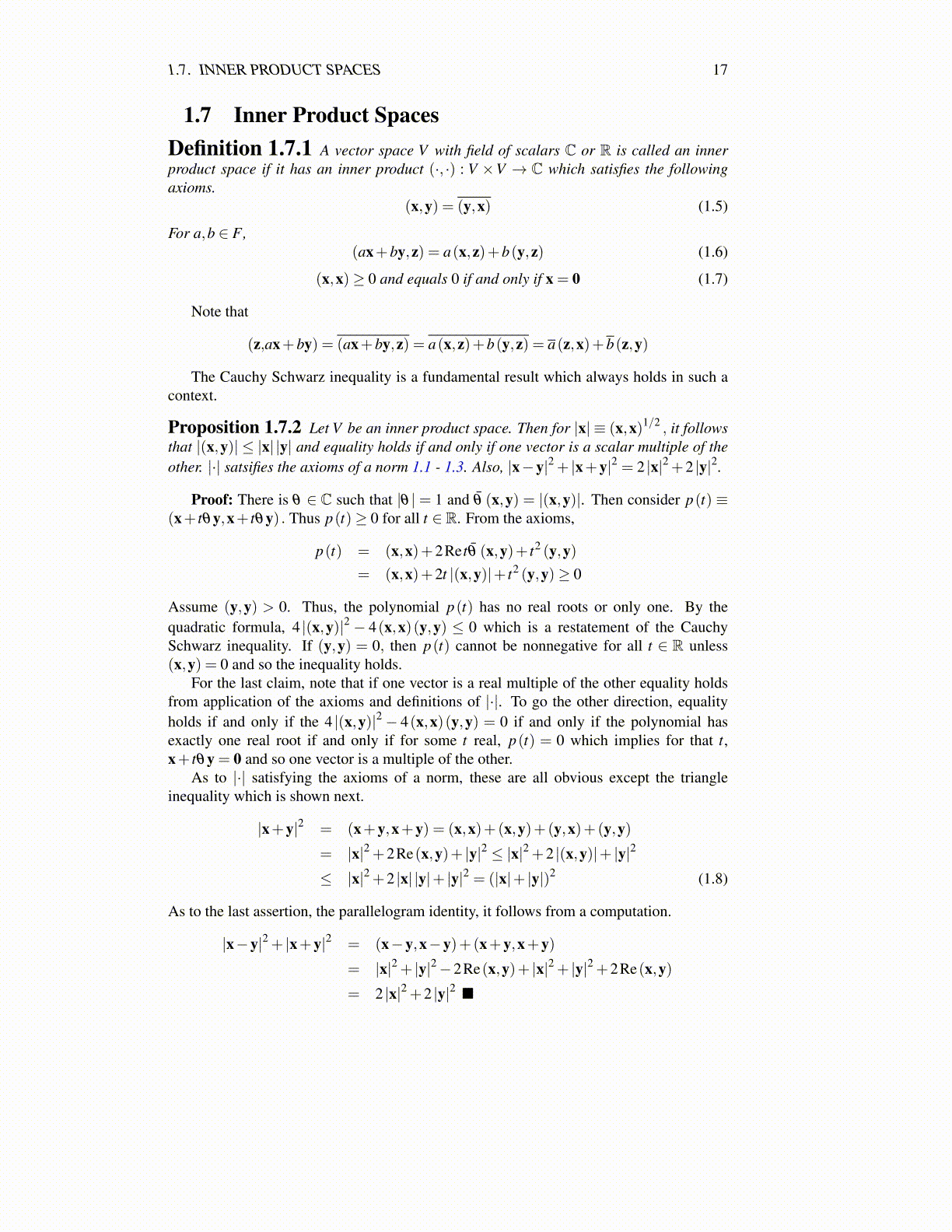
1.7. INNER PRODUCT SPACES 17
1.7 Inner Product SpacesDefinition 1.7.1 A vector space V with field of scalars C or R is called an innerproduct space if it has an inner product (·, ·) : V ×V → C which satisfies the followingaxioms.
(x,y) = (y,x) (1.5)
For a,b ∈ F,(ax+by,z) = a(x,z)+b(y,z) (1.6)
(x,x)≥ 0 and equals 0 if and only if x = 0 (1.7)
Note that
(z,ax+by) = (ax+by,z) = a(x,z)+b(y,z) = a(z,x)+b(z,y)
The Cauchy Schwarz inequality is a fundamental result which always holds in such acontext.
Proposition 1.7.2 Let V be an inner product space. Then for |x| ≡ (x,x)1/2 , it followsthat |(x,y)| ≤ |x| |y| and equality holds if and only if one vector is a scalar multiple of theother. |·| satsifies the axioms of a norm 1.1 - 1.3. Also, |x−y|2 + |x+y|2 = 2 |x|2 +2 |y|2.
Proof: There is θ ∈ C such that |θ | = 1 and θ̄ (x,y) = |(x,y)|. Then consider p(t) ≡(x+ tθy,x+ tθy) . Thus p(t)≥ 0 for all t ∈ R. From the axioms,
p(t) = (x,x)+2Re tθ̄ (x,y)+ t2 (y,y)= (x,x)+2t |(x,y)|+ t2 (y,y)≥ 0
Assume (y,y) > 0. Thus, the polynomial p(t) has no real roots or only one. By thequadratic formula, 4 |(x,y)|2 − 4(x,x)(y,y) ≤ 0 which is a restatement of the CauchySchwarz inequality. If (y,y) = 0, then p(t) cannot be nonnegative for all t ∈ R unless(x,y) = 0 and so the inequality holds.
For the last claim, note that if one vector is a real multiple of the other equality holdsfrom application of the axioms and definitions of |·|. To go the other direction, equalityholds if and only if the 4 |(x,y)|2 − 4(x,x)(y,y) = 0 if and only if the polynomial hasexactly one real root if and only if for some t real, p(t) = 0 which implies for that t,x+ tθy = 0 and so one vector is a multiple of the other.
As to |·| satisfying the axioms of a norm, these are all obvious except the triangleinequality which is shown next.
|x+y|2 = (x+y,x+y) = (x,x)+(x,y)+(y,x)+(y,y)= |x|2 +2Re(x,y)+ |y|2 ≤ |x|2 +2 |(x,y)|+ |y|2
≤ |x|2 +2 |x| |y|+ |y|2 = (|x|+ |y|)2 (1.8)
As to the last assertion, the parallelogram identity, it follows from a computation.
|x−y|2 + |x+y|2 = (x−y,x−y)+(x+y,x+y)= |x|2 + |y|2−2Re(x,y)+ |x|2 + |y|2 +2Re(x,y)= 2 |x|2 +2 |y|2 ■